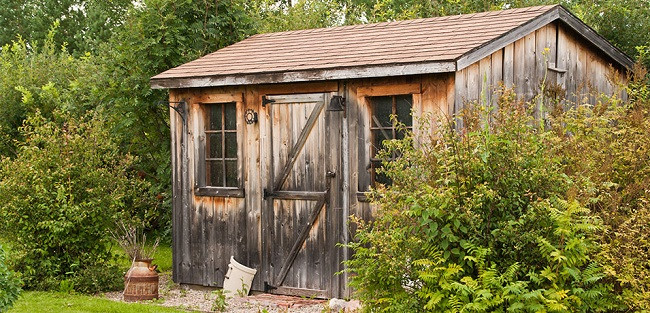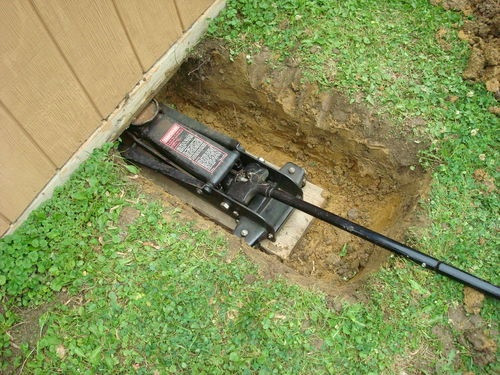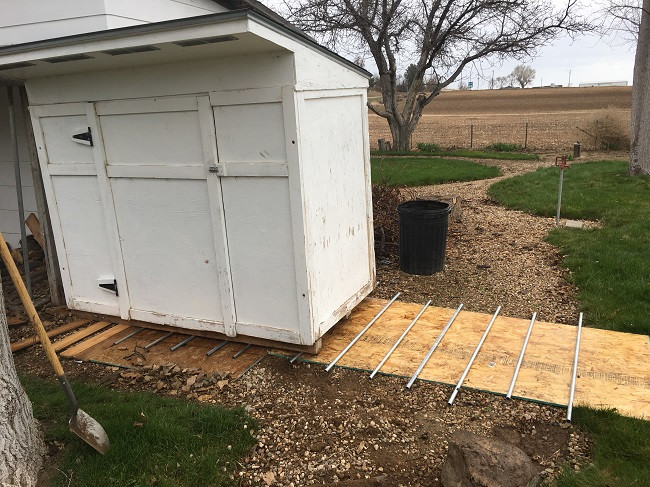How to Move a Shed
Published: 27/08/2021

Sheds are vital parts of any garden – they can provide useful storage space, office space, or (in some cases) even a place to live or entertain friends. But what happens when you move into a new property, and you find the door is hard to access? And what do you if you want more natural light inside? Yes, that’s right – you need to know how to move a shed. You may be in the process of assembling a shed in one spot of your garden but have an inkling that you’ll need to move it in the future. You could you even want to know how to move your shed from one property to another. And how do you move a shed by yourself? All of which leads us to a larger question...
Is all this possible?
On the question of whether you can move a shed once built, the answer is yes. But…
How easy is it to move a shed?
Well, it isn't easy at all - but it is doable. To move your shed, you have three basic options:
- Pay a professional shed moving company to do the work
- Dismantle your shed first
- Find out how to move a shed without dismantling it
If at all possible, we’d recommend the first option. But if you must do the work yourself, you’ll find out how to disassemble your garden building in our article on how to dismantle a shed. Why don’t we recommend moving a shed without dismantling it? Because due to the weight and dimensions of the shed, it is more likely to twist. Plus, you’re more likely to need to build a new shed base – and you certainly will if it’s a concrete shed base. In addition, moving your shed without dismantling could void the guarantee or warranty on your shed. If the shed is new enough to still be in warranty, check the terms and conditions to understand the legal (and possibly) financial risks of moving your shed without dismantling it BEFORE doing so.
Why you should use a shed moving service (if possible)

Using a shed moving service may help you avoid some of the pitfalls of doing the work yourself. As professionals, these sorts of companies are trained and can make quick work of moving a shed – and there’s a much lower risk of damage too. The only real sticking point is the price, which leads us naturally to the next question…
How much does it cost to move a shed in the UK?
This is not an easy question to answer every shed moving service sets its own prices – often very different from the next firm. Cost factors to consider include the following:
The size of your shed
As you’re no doubt aware, garden sheds are available in a range of shapes and sizes. And bigger (or more cumbersome), the longer it will take to move – and the more it’ll cost.
Removal options
Does the removal company offer a shed moving service? Some companies specialise in general removals. If a company doesn’t usually do this kind of work, they may quote a higher price to put you off, or to compensate for work they either don’t enjoy or don’t have the relevant equipment to move your shed securely.
Availability
Following the principle of supply and demand, a shed moving company’s availability could affect what they charge. For example, if the company’s employees are snowed under with work, they may only be available at weekends, which could mean they quote a higher to make up for the loss of free time.
How far you’re moving the shed
Another factor is the distance between where your shed sits at the moment and where you want it to sit. For example, it’ll surely cost more to move the shed from one city to another than it would to transfer from one end of a small garden to another section of the same garden.
10 (and a bit) steps for moving a shed
At this point, we’ve told you that we don’t recommend moving a shed by yourself for various reasons. That said, we also understand there are reasons why you may wish to move a shed yourself – including cost. With this in mind, the following information describes how to move a shed without dismantling it:
1. Decide whether – and how – to move it
Not all sheds are suitable for moving. And this is the case whether you wish to move to the other side of your garden or to a different property.
How old is the shed?

If your shed is old, it may not be able to withstand the rigours of a move as the process can put stress on its structure. In this case, it’d be best to buy a new shed. But if there’s nothing wrong with the structure, it should be fine to move (as long as you continue to follow these steps).
How big is the shed?
The bigger your shed, the heavier it is likely to be. And this, in turn, will determine the method you use to transport it. A note on moving larger sheds While it can be done with small-to-medium-sized sheds, you really shouldn’t consider moving a shed yourself – by doing so, you’d be risking injury and/or damage to the shed.
Is it possible (or safe) to move it?
Is the shed cemented to the ground? If so, you may not be able to move it at all – at least not without adding a completely new floor panels (the old ones will surely be ruined if you try to prise it from the cement). Note: As most shed manufacturers don’t offer replacement floor panels, this could pose an issue.
How should you move your shed?
Methods of moving a shed (without dismantling it) include:
- Rollers – Good for moving your shed from end of the garden to another
- Pickup truck – if transporting small sheds (of 6 feet long or less) on longer distances (e.g. from one town to another)
- Trailer – if transporting sheds of 8’ (or more) long
- Forklift – suitable for 8’x6’ sheds or smaller
If you’re moving your shed from one end of a garden to the other, we recommend using the roller method. While the forklift is a useful tool for moving sheds, we would only recommend using it yourself if you have experience. If you’re simply moving the building a considerable distance (e.g. from one town or village to another), a mix of rollers and a pickup truck (or trailer) would be a good option. This would work by using the rollers to move the shed before using a forklift, jack, or ramp to lift it on to the pickup or trailer.
2. Grab the right equipment

Once you’ve decided how to move your shed, you can start to gather all the equipment you need. Here's a list of the equipment you may need to move your shed:
- Shovel
- PVC or metal pipes or poles
- Wooden braces
- Car jack
- Pickup trucker or trailer (shed size dependent)
Assuming you don’t have the training to use a forklift, you should use PVC pipes as rollers – pipes that are at least 4” (approx. 10cm) in diameter. How many you need depends on the size of your shed, but 4-6 should be enough in most cases (the exact number depends on the size).
3. Empty your shed
The most popular size of shed is 8’x6’. And if you consider that an 8x6 shed usually weighs between 200kg and 225kg, you really don’t want to add yet more weight to carry! You’ll also want to avoid the items crashing about inside during the move – that way you’ll avoid potential damage to the inside of your shed and to the items themselves. Make it easier on yourself by removing everything in the shed before you start.
4. Secure the structure
Even the best sheds are wooden structures held together by nails or screws. And with this in mind, they’re not designed to be moved. Even sheds with a 20-year guarantee are designed to sit in one place. For this reason, you’ll need to secure the structure at its weak points – paying particular attention to the window and door openings.
Windows
Remove the panes from the window openings and attach two wooden braces to the studs – one that goes from top left to bottom right and another that goes from top right to bottom left. This should also form an X-shape.
Doors
To secure the door opening(s), remove the door(s) to prevent them getting twisted or damaged (or even causing damage) during transit. Next, add two wooden braces to the studs of each opening. One wooden brace should run from top right to bottom left, and the other must run from top left to bottom right. As in the case of the windows, the door-opening braces should form an X-shape.
5. Prepare the new space for the move
Clear access is vital to ensuring that the process of moving your shed goes by without a hitch. If the path or grass is bumpy or there are obstructions in the way, this will make it harder to do the job – so make it easy on yourself! To prepare the new area for the shed, rake the area, mow the grass, and clear away any debris.
6. Dig under the shed
We mentioned the weight of sheds earlier in this post – and that’s because they weigh a tonne (sometimes literally)! As a result, the sheer weight of it may have caused it to sink down. For this reason, you’ll need to dig it out. Use a shovel to dig out six-inch gaps at different intervals around the shed (particularly around the corners). This will create gripping points that allow you to lift the building.
7. Lift the shed

This step is relatively simple – as long as you have a couple of friends to help you. Here, you need to lift the shed at one end – this will allow you to place the rollers underneath. To do this, you need a car jack. As long as you dug out the shed properly (as in the last step), all you need to do is lever it up. Have your friends keep the other side of the shed in position. Once you raise the building high enough, it’s time to move your shed!
8. Move the shed

Once you’ve raised the shed, it’s time to roll your PVC pipes under the shed.
Do you need to rotate the shed?
If you don’t need to rotate the building, place the ends of each pipe sit perpendicular to the direction you want to move the building, and at least a couple of feet apart. If you do need to rotate the shed, position the pipes so they’re parallel to the building.
What if the ground is soggy or wet?
This is a good question – and an important one! After all, wet ground will make things tougher! In this case, lay down a thin wooden platform to create a clear path.
Get moving
As long as you’ve prepared the path to either the new destination or the vehicle for loading (if transporting to another location), and the poles are in place, you (and the friends helping) can now roll the shed to the required spot. Note: If you’re moving your shed to another property that is some distance away, follow steps 9a and 9b. But if you’re moving your shed from one end of your garden to another end, go to step 10.
9a. (If moving to another property) load the shed on to the vehicle and transport it

If you’re moving the shed to another property (perhaps in another town), you’ll need start by loading it on to the back of the pickup truck or trailer – arguably the most difficult part! As long as you have a big enough car jack, use it to lever up the shed and slide it straight on to the back of the pickup truck. If you’re using a trailer with a ramp, you and your helpers could use your collective strength to push it up the ramp and on to the vehicle.
9b. (If applicable) unload the shed at the new property
This process is simply steps 8 to 9a in reverse.
10. Lay the shed in its new position
Use the jack to lift up the shed. Once again, you’ll need your friends to help keep it in position. Next, remove the pipes from under the shed and leave it to settle in its new spot.








